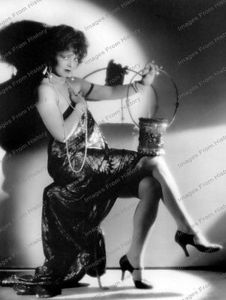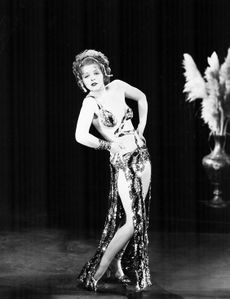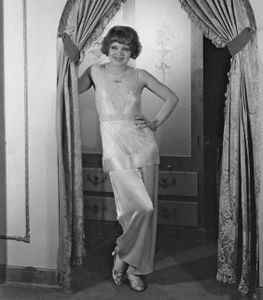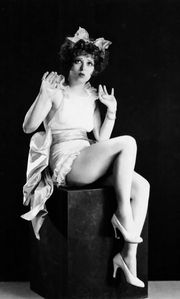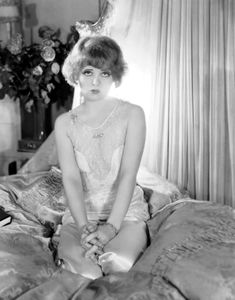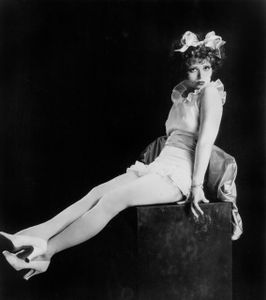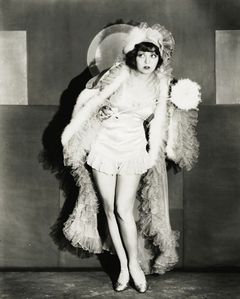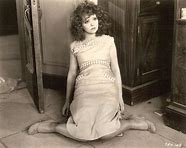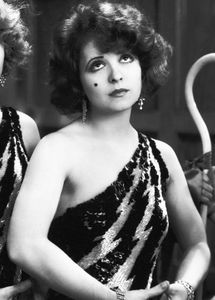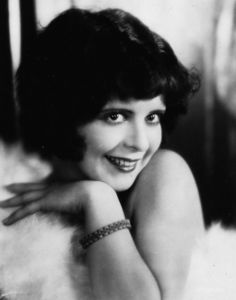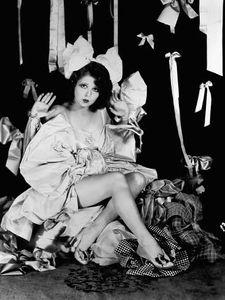Clara Bow
Click here for Early Movie History category page |
Clara Bow (born Clara Gordon Bow, July 29, 1905 – September 27, 1965) was an American actress and sex symbol who rose to fame in the silent film era of the 1920s. Bow was renowned for her sexual magnetism and became known around the world as the It girl, where "It" was commonly understood to mean sex appeal. She was regarded as a quintessential flapper.
Early life
Bow was born in a tenement in Brooklyn, New York, as the only surviving child of a dysfunctional family afflicted with mental illness, poverty, and physical and emotional abuse. She was the third child born to her parents; the first two children, also daughters, had short lives: one lived for 2 hours, and the other lived for two days. Bow's mother, anticipating that her third child would also die at birth, did not bother with a birth certificate. Clara's father was of Scotch-Irish descent.
As a child, she was a tomboy and played games in the streets with the boys. Her clothes were ragged and dirty, so other girls wouldn't play with her. Clara's friend Johnny was severely burned and died in her arms when she was eight or nine years old. Years later, she could make herself cry at will on a movie set by singing the lullaby "Rock-a-bye Baby". She said it reminded her of Johnny.
Bow's mother, Sarah Gordon, was an occasional prostitute who suffered from mental illness and epilepsy. She was known for her frequent public affairs with local firemen. Bow's father, Robert Bow, was rarely present and may have had a mental impairment. Whenever he returned home, he was verbally and physically abusive to both his wife and daughter. Reports indicate that Bow's father raped her when she was between 15 and 16 years old.
Early career
Always an avid movie fan, Bow entered and won the Motion Picture Magazine's Fame and Fortune contest in 1921, the grand prize being a part in a film. According to articles in Motion Picture Classic from February, March, and April 1928, in which she told her life story, she talked her father into giving her one dollar to have some pictures made that she could submit to the contest's judges. Her father gave her the dollar, and she went to a Brooklyn photographer, who took two pictures of her, which she said "were terrible". Although she hated the images of her wearing a red tam and her only dress, the contest judges were impressed. After numerous screen tests, Bow was selected the winner. She won a part in Beyond the Rainbow (1922), but to her humiliation and disappointment, her scenes were cut from the final print and were not seen until the film was restored years later. Bow preferred playing poker with her cook, maid, and chauffeur over attending her movie premieres.
Bow also had to deal with her mother, Sarah Gordon, who told Bow that acting was for prostitutes. Gordon had also taken to sneaking up behind Bow and threatening to kill her because she felt her daughter would be better off dead. One night, she awoke to find her mother holding a butcher knife to her throat. Clara ran and locked herself in a closet until her grandmother came home. Bow suffered from insomnia for the rest of her life.
Fame and fortune
Bow's screen introduction wasn't until her next film, Down to the Sea in Ships. This was a silent film, as were all of Bow's early films until the advent of sound in the late 1920s.
She began to appear in numerous small movie roles. All the while, she suffered guilty feelings over her mother's disapproval. In 1923, Bow was on the set when she learned that her mother had died. She was devastated, feeling that her acting was somehow responsible for her mother's death.
With her earliest films being all East Coast productions, Bow got her big break when an officer of Preferred Pictures approached her on the set. He offered her free train fare to make a screen test in Hollywood, and Bow agreed to make the trip. The first time Preferred Pictures head B.P. Schulberg saw disheveled Clara Bow in her one ragged dress, he was dismayed. He was reluctant even to give her a screen test, but when he finally did, the results astounded him. Bow was already adept at pantomime, and she could cry on command.
Starting with Maytime (1923), Schulberg cast Bow in a series of minor roles. She nearly always stole her scenes. However, instead of creating projects for her, he loaned her out to other studios for easy money. Nevertheless, Bow started to make a name for herself through these minor roles and was selected as one of the WAMPAS Baby Stars in 1924.
As soon as Bow started making money, she brought her father to live with her in Hollywood. For the next few years, she funded numerous business ventures for him, including a restaurant and a dry cleaners, all of which failed. He soon became a drunken nuisance on her sets, where he would try to pick up young girls by telling them his daughter was Clara Bow. Despite the behavior of her unwanted relative, Bow was adored during this time of her career. Crew members always seemed to fall in love with her. She was friendly, generous, and so grateful for her success that she always remained humble.
In 1925, Schulberg cast Bow in The Plastic Age. The movie was a huge hit, and Bow became the studio's most popular star overnight. She also began to date her co-star Gilbert Roland, who would become the first of many engagements for her. Bow followed her first big success with Mantrap (1926), directed by Victor Fleming. Though he was twice her age, Bow quickly fell in love with her director. She began seeing both Roland and Fleming at the same time.
- The 'It' Girl photos
The "It" girl
In 1927, Bow reached the height of her popularity with the film "It," which was based on a story written by Elinor Glyn. Upon the film's release and popularity, Clara Bow became known as the "It Girl". In Glynn's story, It, a character explains what "It" really is: "It...that strange magnetism which attracts both sexes...entirely unself-conscious...full of self-confidence...indifferent to the effect...she is producing and uninfluenced by others.") More commonly, "It" was taken to mean sex appeal. "It, hell," quipped Dorothy Parker, "She had those."
This image was enhanced by various off-screen love affairs publicized by the tabloid press. However, some Hollywood insiders considered her socially undesirable, especially in light of rumored sexual escapades with many famous men of the time. Bela Lugosi, Gary Cooper, Gilbert Roland, John Wayne, director Victor Fleming, and John Gilbert were reputed to have been among her many lovers.
Bow's alleged alcoholism, drug abuse, and mental illness were also becoming problems for the studios. Budd Schulberg, the producer's son, wrote in his memoir Moving Pictures, "There was one subject on which the staid old Hollywood establishment would agree: Clara Bow, no matter how great her popularity, was a low life and a disgrace to the community."
However, Bow was praised for her vitality and enthusiasm - Adolph Zukor once said that "She danced even when her feet weren't moving" - although her roles rarely allowed her to show much range. In the early 1930s, Motion Picture magazine complained that the studio never gave her film plots any thought beyond "Hey, let's put Clara in a sailor suit!" At least one crucial film writer, Adela Rogers St. Johns, felt that Bow had enormous promise that the studios never tapped.
Documentation indicates that as Bow developed a reputation as "Crisis-a-Day Clara". Paramount went out of its way to humiliate the increasingly emotionally frail actress by canceling her films, docking her pay, charging her for unreturned costumes, and insisting that she pay for her publicity photographs. Her contract also included a morality clause offering her a bonus of $500,000 for behaving like a lady and staying out of the newspapers.
In 1927, Bow starred in Wings, a war picture largely rewritten to accommodate her, as she was Paramount's biggest star at the time. The film went on to win the first Academy Award for Best Picture. Afterwards, Bow's career continued with limited success into the early sound film era. She worried (correctly) that her strong Brooklyn accent would destroy much of her mystique. Bow began experiencing microphone fright on the sets of her sound films. A visibly nervous Bow had to do several retakes in The Wild Party, her first talkie, because her eyes kept wandering up to the microphone overhead.
In 1928, Bow wrote the foreword for a novelization of her film The Fleet's In. Between the years 1927 and 1930, Bow was also one of Hollywood's top five box office attractions as well.
Honors
For her contributions to the motion picture industry, Clara Bow was given a star on the Hollywood Walk of Fame. In 1994, she was honored with an image on a United States postage stamp designed by caricaturist Al Hirschfeld.
Bow in popular culture
- In Tennessee Williams' play The Night of the Iguana, Hannah Jelkes explains to Reverend Shannon that when she was 16, a young man made advances toward her in a movie theatre and was arrested. To get him off the hook, she says, "I told the police it was a Clara Bow picture-well, it was a Clara Bow picture-and I was just over-excited."
- The alternative rock band "50 Foot Wave" entitled a song "Clara Bow" on their CD Golden Ocean.
- Bow is mentioned in the song "Condition of the Heart" by Prince on his album Around the World in a Day.
- Max Fleischer's cartoon character Betty Boop was modeled after Bow and entertainer Helen Kane (the "boop-boop-a-doop-girl").
- Bow's mass of tangled red hair was one of her most famous features. When fans of the new star found out she put henna in her hair, sales of the dye tripled.
- Bow applied her red lipstick in the shape of a heart. Women who imitated this shape were said to be putting a "Clara Bow" on their mouths.
- Bow was mentioned in the lyrics of the song "Chop Suey" in Rodgers & Hammerstein's musical comedy Flower Drum Song
- She is Effy's idol in the E4 popular show Skins.
Filmography
- Beyond the Rainbow (1922)
- Down to the Sea in Ships (1922)
- Enemies of Women (1923)
- The Daring Years (1923)
- Maytime (1923)
- Black Oxen (1923)
- Grit (1924)
- Poisoned Paradise (1924)
- Daughters of Pleasure (1924)
- Wine (1924)
- Empty Hearts (1924)
- Helen's Babies (1924)
- This Woman (1924)
- Black Lightning (1924)
- Capital Punishment (1925)
- The Adventurous Sex (1925)
- Eve's Lover (1925)
- The Lawful Cheater (1925)
- The Scarlet West (1925)
- My Lady's Lips (1925)
- Parisian Love (1925)
- Kiss Me Again (1925)
- The Keeper of the Bees (1925)
- The Primrose Path (1925)
- Free to Love (1925)
- The Best Bad Man (1925)
- The Plastic Age (1925)
- The Ancient Mariner (1925)
- My Lady of Whims (1925)
- Dance Madness (1926)
- Shadow of the Law (1926)
- Two Can Play (1926)
- Dancing Mothers (1926)
- Fascinating Youth (1926)
- The Runaway (1926)
- Mantrap (1926)
- Kid Boots (1926)
- It (1927)
- Children of Divorce (1927)
- Rough House Rosie (1927)
- Wings (1927)
- Hula (1927)
- A Trip Through the Paramount Studio (1927) (short subject)
- Get Your Man (1927)
- Red Hair (1928)
- Ladies of the Mob (1928)
- The Fleet's In (1928)
- Three Weekends (1928)
- Hollywood Snapshots #11 (1929) (short subject)
- The Wild Party (1929)
- Dangerous Curves (1929)
- The Saturday Night Kid (1929)
- Paramount on Parade (1930)
- True to the Navy (1930)
- Love Among the Millionaires (1930)
- Her Wedding Night (1930)
- No Limit (1931)
- Kick In (1931)
- Call Her Savage (1932)
- Hoop-La (1933)
Further reading
- Silent Stars
- TCM Film Guide, "Leading Ladies: The 50 Most Unforgettable Actresses of the Studio Era", Chronicle Books, San Francisco, California, 2006.
- The Silencing of Clara Bow
External links
- Clara Bow at the Internet Movie Database
- Clara Bow at the Turner Classic Movie Database
- Photographs of Clara Bow
- The Clara Bow Page
- Clara Bow @ Find A Grave
- Clara Bow's death certificate
- Photographs and bibliography
- Clara Bow My Life Story
Chat rooms • What links here • Copyright info • Contact information • Category:Root

